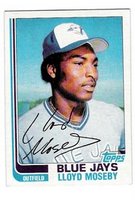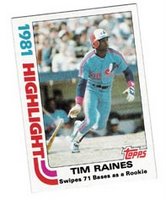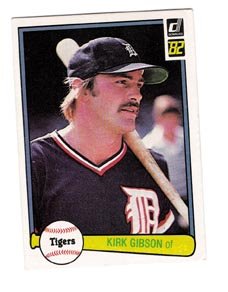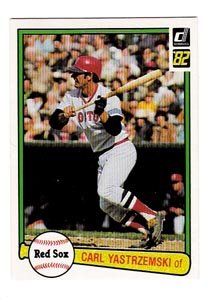 You’ve gotta hand it to Fleer: this is a fantastic re-introduction to the hobby. Just the fact that Rickey Henderson got two cards and others had out-of-the-ordinary text where tradition dictated the player’s name, team and position should have been (see the Willie Wilson and the Mike Schmidt cards), are reason enough to root for this set. I can’t imagine Topps doing anything like that on the front of their cards, and certainly not Donruss. In 1981, Donruss’ editors were still fighting over who got to eat more paste during craft hour. Seriously, for Fleer to be on the ball like that is inspired. They knew their opposition would be tough (the 1981 Topps design is a winner) and they knew there would be another new entry (Donruss), so they put out a strong set with a few surprises.
You’ve gotta hand it to Fleer: this is a fantastic re-introduction to the hobby. Just the fact that Rickey Henderson got two cards and others had out-of-the-ordinary text where tradition dictated the player’s name, team and position should have been (see the Willie Wilson and the Mike Schmidt cards), are reason enough to root for this set. I can’t imagine Topps doing anything like that on the front of their cards, and certainly not Donruss. In 1981, Donruss’ editors were still fighting over who got to eat more paste during craft hour. Seriously, for Fleer to be on the ball like that is inspired. They knew their opposition would be tough (the 1981 Topps design is a winner) and they knew there would be another new entry (Donruss), so they put out a strong set with a few surprises. No one card from the set is valuable. But this set (and really 1981 in general) is not about value—and it never will be. There’s just nothing of historical importance (and thus value) here; even the rookies don’t command much over $6. Is that a
 hindrance in its being a good set? I don’t think so. Look at 1986 Topps: it was a great set despite there not being any real money cards. Topps even missed the boat on Canseco and it didn’t matter because Topps knew what made a set great: a nice checklist, good special cards and more than one card of popular players. It isn’t brain surgery; by 1986 Topps could put together a strong, diverse (but largely value-less) set in their sleep (see 1984). But for a card company to know this right out of the gate, well, it certainly sets you up as a legitimate opponent to the establishment, and sets you apart from the paste-eaters.
hindrance in its being a good set? I don’t think so. Look at 1986 Topps: it was a great set despite there not being any real money cards. Topps even missed the boat on Canseco and it didn’t matter because Topps knew what made a set great: a nice checklist, good special cards and more than one card of popular players. It isn’t brain surgery; by 1986 Topps could put together a strong, diverse (but largely value-less) set in their sleep (see 1984). But for a card company to know this right out of the gate, well, it certainly sets you up as a legitimate opponent to the establishment, and sets you apart from the paste-eaters. Too bad about 1982.
25. 1983 Donruss
First things first: 1982 had the bat and ball, 1983 had the bat and the glove. Got it? Yes, the front of card design offerings from Donruss in 1982 and 1983 were a little suspect. And while today it looks as though their heads were surely up their asses at Donruss in the early years (which makes the 1984 set that much more unbelievable), it would’ve taken a first-class moron to screw up 1982 and 1983, and Donruss apparently fired their first-class guys after they approved printing the 1981 set on wax paper.
 In 1982 they came up with a unique selling point to distinguish themselves from Fleer: the Diamond King. Then they traded in their DIY design team from 1981 (consisting of the lead graphic designer’s wife and children) for the slick ‘hey-everybody-it’s-a-baseball-card-let’s-put-a-goddamn-baseball-on-it’ design they knew had legs enough to regurgitate in 1983.
In 1982 they came up with a unique selling point to distinguish themselves from Fleer: the Diamond King. Then they traded in their DIY design team from 1981 (consisting of the lead graphic designer’s wife and children) for the slick ‘hey-everybody-it’s-a-baseball-card-let’s-put-a-goddamn-baseball-on-it’ design they knew had legs enough to regurgitate in 1983. So then which was the better set, 1982 or 1983? My money’s on 1982 and here’s why. 1982 had the better design, a better Diamond King checklist and the rookie of that disabled-list-prone, no-power infielder from the ho-hum Orioles, Cal Ripken, Jr., plus second-tier rookies George ‘Call Me Jorge’ Bell, Steve Sax, Lee Smith, Dave Stewart and Kent Hrbek. 1982 was a monster improvement from 1981 in terms of design, overall worth and checklist.
1983 had last-year, regular issue cards of Yaz and Bench and, more importantly, the better rookie checklist. And not only Boggs, Gwynn and Sandberg, but also other, less-prominent rooks: Frank Viola, Julio Franco on the Phillies (another stellar player dumped by Mayor McCheese, Phillies GM extraordinaire) and Willie McGee.
Going back to Diamond Kings for a second, let’s compare the 1982 and 1983 lineups. 1982 boasts nine Hall of Famers, Pete Rose, Alan Trammell, Daves Kingman and Parker and Buddy ‘Ric Flair’ Bell. 1983 has eight Hall of Famers (including nice doffs of the cap to Bench and Yaz), Eighties dynamo Fernando Valenzuela and Rickey ‘Play Til I’m Eighty’ Henderson. More importantly, in 1982 the Diamond King Suck Factor was much lower than it was in 1983. In 1982, there was a 46.15% chance that if you got a Diamond King in a pack it was going to suck and be Roy Smalley, Ivan DeJesus or ten other guys just happy to be there. In 1983, the Suck Factor hit 50% with the Suck King Award going to Britt Burns of the Chicago White Sox (#23).

1980s Donruss Diamond King Suck Factor percentages
(SK = Suck King)
1981: 100% No Diamond Kings
1982: 46.15% Mike Norris, A’s (SK)
1983: 50% Britt Burns, White Sox (SK)
1984: 59.62% tie: Jim Clancy, Blue Jays; Matt Young, Mariners (SK)
1985: 65.38% Charlie Lea, Expos (SK)
1986: 61.54% Rick Mahler, Braves (SK)
1987: 50% Jim Presley, Mariners (SK)
1988: 38.46% Glen Hubbard, Braves (SK)
1989: 30.77% Dave Schmidt, Orioles (SK)
Diamond Kings were almost like the Topps All-Star cards in the 1980s: hard to get that first one in a pack, then suddenly you’ve got a hundred Dave Draveckys, Gerald Perrys and Damaso Garcias. Seriously, I get it that they wanted to give the DK to a different guy every year, but they really should’ve designated some teams as hopeless (ie Braves and Mariners) and given it every year to either their best player, an owner (how much fun would it have been to get a Ted Turner Diamond King?) or a stadium (Kingdome, anyone?). Or better yet, for every year that a team didn’t deserve to have a Diamond King, Donruss should’ve replaced that designated card with one of the San Diego Chicken, the Phillie Phanatic, Morganna or Mariano Duncan (is it just me or did Mariano look a hell of a lot like the lead Muppet in The Dark Crystal? Look at his 1986 Topps card and tell me they weren’t separated at birth…and yes, ‘separated at birth’ does imply that Duncan was created in the Jim Henson creature shop).
Anyway, I always thought 1982 was the better of the two.
24. 1982 Topps
 Speaking of 1982, this Topps set is officially the ugliest Topps set of the Eighties. It’s disheartening on numerous levels: because a) Topps rarely (and this is according to me) put out an ugly set, b) the lone highlight of the design was the facsimile signature, c) it was such a strong set checklist-wise, d) it was one of the last years when Topps truly owned the baseball card racket, and e) with so many great things about this set, it’s a fucking shame Topps delegated the card design to their junior college summer interns. With better design (the facsimile signature notwithstanding, which always make for a good design, by the way), this could’ve been a Top 15 set.
Speaking of 1982, this Topps set is officially the ugliest Topps set of the Eighties. It’s disheartening on numerous levels: because a) Topps rarely (and this is according to me) put out an ugly set, b) the lone highlight of the design was the facsimile signature, c) it was such a strong set checklist-wise, d) it was one of the last years when Topps truly owned the baseball card racket, and e) with so many great things about this set, it’s a fucking shame Topps delegated the card design to their junior college summer interns. With better design (the facsimile signature notwithstanding, which always make for a good design, by the way), this could’ve been a Top 15 set.
Ten Ugly Years
1. 1966
2. 1982
3. 1958
4. 1974
5. 1973
6. 1964
7. 1990
8. 1993
9. 1975
10. 1978
When you assess a set, there are a couple places you can start. Maybe you start with design, or subsets or rookies or the distribution of stars amongst commons (checklist). If a set doesn’t excel in any, it’s probably going to be a bad set. If it excels in at least two of these categories it’s good enough; a weak three out of four makes it pretty good, a strong three out of four makes a set great, and four out of four makes for a classic. I would give 1982 Topps a strong three out of four. Here’s why.
Topps has always made a point of scattering the stars across the set, something I’ve always found enticing; you’re not bored with the set after a certain number because you know that you haven’t seen Yount or Fisk or Winfield or some other star yet. 1982 is no exception—you can’t go more than ten cards without hitting at least a minor star; each hundred cards features the regular cards of at least 6 great players (1-100: 7 regular cards of superstars; 101-200: 6; 201-300: 4; 301-400: 5; 401-500: 7; 501-600: 4; 601-700: 7; 701-792: 6). And that’s not including subset cards, of which there is a bounty. And really, this is how it’s supposed to be with a base of ten and a numerical merit system…anyway, I’ve longwindedly gone on about this before, so I’ll save space here and say that, in keeping with the traditionally strong Topps checklist, 1982 succeeds in keeping the collector’s interest across the set.

Subset-wise, 1982 has more different ones than any other set of the Eighties (or at least it feels that why). All-Stars, Highlights, Team Leaders, League Leaders and the ubiquitous In Action cards. 1982 Topps was all about the ‘In Action’ card. When was the last time Topps did an IA subset? 1972? It’s a cool idea, especially for a set defined by the headshot and posed action shot. But by 1982, the action shot was becoming more accepted as a photo for a regular card. I think this hurts the IA set. The IA set is also hurt by the horribly ugly, paint on cinderblock in a hallway at a rec center look the design covets. It’s a shame.
So it’s got a strong checklist, a wide variety of quality subsets and, perhaps most importantly, a strong rookie class in terms of both short and long-term rookie impact. Obviously, there’s the Ripken. But there’s Kent Hrbek, Steve Sax, Dave Stewart, George Bell and Lee Smith in the second tier and Tim Wallach, Chili Davis, Jesse Barfield, Brett Butler and Steve Bedrosian in the third tier, plus other little guys like Rich Gedman, Terry Francona and the peculiar inclusion of Bruce Hurst on the Red Sox Future Stars card, even though he was featured on the 1981 Future Stars card). All in all, not a bad rookie lineup.
 But really, it comes back to the design. It’s the design that keeps this set from ranking higher. Like 1982 Fleer, the set feels cheap. I think the design contributes heavily to this. Look, it even performs badly as a basketball card. Just a poor, uninspired choice after the fun 1981 design.
But really, it comes back to the design. It’s the design that keeps this set from ranking higher. Like 1982 Fleer, the set feels cheap. I think the design contributes heavily to this. Look, it even performs badly as a basketball card. Just a poor, uninspired choice after the fun 1981 design. 23. 1988 Score Rookie/Traded
I actually can’t believe that this set is so high, but here it is. There were a few sets that, when they came out, were the hottest shit of the year, and 1988 Score Rookie/Traded, if I remember correctly, was the hottest shit of 1988. Because really, who expected this set? Nobody, that’s who. And in the tradition of the hot shit traded set, not only did nobody see it coming, but it had a whole bunch of rookies that were hot at the time. It almost didn’t matter that half of them didn’t pan out and now the set is virtually worthless. Remember when the Biggio was right around $15, you’d cut off your non-writing arm for the Mark Grace and the Alomar was a $40 card? Me too. Fuck, I wanted this set.
22. 1982 Donruss
 This was the strongest set of 1982. I don’t care what I just said about 1982 Topps. Sure, Topps had all the trappings of a great set, but because the design sucked, it wasn’t. 1982 Donruss had a great design, had great photography (for that year), Ripken got his own card, Babe Ruth was the puzzle and did I mention that it was the first year of Diamond Kings? Awesome all around. It took Donruss two more years to bring out the Rated Rookie (and thus take over baseball cards), but 1982 was really Donruss’ first legitimate year as a baseball card manufacturer. It was the first year with the very bizarre, very technical card back design (reminiscent of that carefully-folded sheet of multiple-language legalese found in the box with your new Casio alarm clock) featuring not very many years of stats, some career highlights notes and a player’s transaction details (a feature that would set Donruss cards apart for over a decade).
This was the strongest set of 1982. I don’t care what I just said about 1982 Topps. Sure, Topps had all the trappings of a great set, but because the design sucked, it wasn’t. 1982 Donruss had a great design, had great photography (for that year), Ripken got his own card, Babe Ruth was the puzzle and did I mention that it was the first year of Diamond Kings? Awesome all around. It took Donruss two more years to bring out the Rated Rookie (and thus take over baseball cards), but 1982 was really Donruss’ first legitimate year as a baseball card manufacturer. It was the first year with the very bizarre, very technical card back design (reminiscent of that carefully-folded sheet of multiple-language legalese found in the box with your new Casio alarm clock) featuring not very many years of stats, some career highlights notes and a player’s transaction details (a feature that would set Donruss cards apart for over a decade). It’s too bad this set didn’t come out in 1981, but because it was the sophomore effort it’s doubly impressive. I don’t think I’ve been overly harsh with my assessment of 1981 Donruss; let’s face it, it just isn’t that good. It’s like that poem you wrote about that girl you never asked out in high school that you thought was still in that trunk in the attic, but somehow Access Hollywood got it when you got famous and showcased it with Pat O’Brien providing slurred-out, coked-up narration—you can’t remember what you were thinking at the time, and now it’s come back to haunt you forever. That’s exactly what 1981 Donruss is to the rest of the sets they put out. (And just as a side note, wouldn’t it be better if it were Pete O’Brien instead of Pat O’Brien? They could even have him in his Rangers uniform…hell, life would
 be so much better if players from the Eighties were always on TV, and always in their uniforms. Pat Tabler, Glenn Davis and Cory Snyder could be the judges on American Idol, Nolan Ryan (in his Astros days) could do a mean Dr. House on House, MD (Patient Dying of Incurable Mystery Disease: Ohhh…my stomach… House: Who told you to take Tylenol? Answer me! Always take two Advil for aches and muscle pain. You hear me? ADVIL!), and Dwight Gooden and Darryl Strawberry could be on COPS. Shit, you know, that last one might actually come true).
be so much better if players from the Eighties were always on TV, and always in their uniforms. Pat Tabler, Glenn Davis and Cory Snyder could be the judges on American Idol, Nolan Ryan (in his Astros days) could do a mean Dr. House on House, MD (Patient Dying of Incurable Mystery Disease: Ohhh…my stomach… House: Who told you to take Tylenol? Answer me! Always take two Advil for aches and muscle pain. You hear me? ADVIL!), and Dwight Gooden and Darryl Strawberry could be on COPS. Shit, you know, that last one might actually come true).So it’s doubly impressive that Donruss rebounded after 1981, bringing out a strong design (that they ripped off in 1983) to compliment a pretty good rookie class and the introduction of Diamond Kings. So here’s to you, 1982 Donruss. Way to go.
Coming Soon: 21 – 18

re: Topps Ten Ugly Years
ReplyDeletefor the most part, i agree with your list, and i would say 1973 was the worst (check out the steve garvey card - it's really a picture of wes parker's back), and 1990 would be a close second. but 1978?!?! that is one of my favorite years. the cursive team script, the position inside the baseball, all star shield, plus the record breakers at the beginning of the set like they should be. i think 1978 is a winner.
To put my two cents in, I liked all of the sets from the previous post (86 Donruss, 83 Fleer, etc) better than the ones on this post. I found 82 and 83 Donruss to be too vanilla. I did like 82 Topps because of the great record breaker cards and the three paneled Ripken rookie.
ReplyDeleteGreatly looking forward to your continued list.
Ugliest set should not be confused with Blandest set. Which is what the majority of your list includes. 58, 64, 66...those were bland years which also hurt from their association with classic sets bookending them.
ReplyDeleteAs for ugliest, you have to go with the poor photo, airbrush, design trifecta that is the 1970 set. Complete absence of color to boot.
Of course, the 1983 Donruss set did have a San Diego Chicken card in it, and you could mail it back to Donruss to get it signed by the Chicken. And the Chicken's autograph looks like it was done in caligraphy. I always wondered if it was really his autograph, or a really good autopen. But it is the first time in my memory that you could get an autographed card through a card company.
ReplyDeletethat James Worthy card messed with my mind man! 1982 Basektball cards, never heard of them, but I looked them up, it's real!
ReplyDeleteThe 1983 Donruss also had Rated Rookies, but they were imprinted on the back of the card, I think Julio Franco was one, you know Julio, the guy who plays for the Mets, NOW.
good post, but i loved the 1975 topps set. the best rookie group of the 1970's hands down, and i loved the colors.
ReplyDeleteI loved the 1975 set! What was wrong with it?
ReplyDelete1982 topps may have had the greatest disparity between design quality for regular cards and subsets... I'm with you on the subsets... they look pretty silly... but the regular cards? that's a great design... head and shoulders above 1988 or 1989... I still remember opening some packs with a friend when the 88 set came out and it took about two seconds for us to agree that they were the ugliest cards we'd ever seen... and that's before we saw the all-star subset... *shudder*
ReplyDeleteif nothing else, the 1982 topps set looks like... well... 1982... and if you ask me, 1982 was a high point for baseball fashion... I mean check out those 1982 uniforms... the powder blues of the phillies, cardinals, blue jays and expos... the navy tigers shirt... the orange orioles and giants jerseys... and of course, my favorite: the astros technicolor rainbow... all that before mentioning the pullover style jerseys... oh, it was a wonderful time for bold uniforms...
I think you are unnecessarily hard on early sets, 1973, 1974, 1982 in particular. The beauty of these cards are in their simplicity, even if some may be kind of bland by today's standards. (Personally, I like the double striping of the 1982 Topps)There's no crappy foil stamping, stupid holographic images, fancy computer enhanced graphics or even pieces of jersey. They're just cool pictures of players who you liked instead of a down payment on a house or your kid's college fund.
ReplyDelete1982 Topps isn't great, but it's far from the worst of the decade. 1988 is an absolute chore to sort through. If it wasn't for 1990 Donruss, I'd say 88 Topps is the worst box of junk wax you can dig into.
ReplyDelete